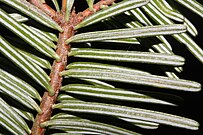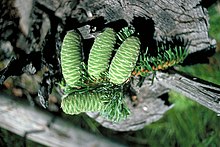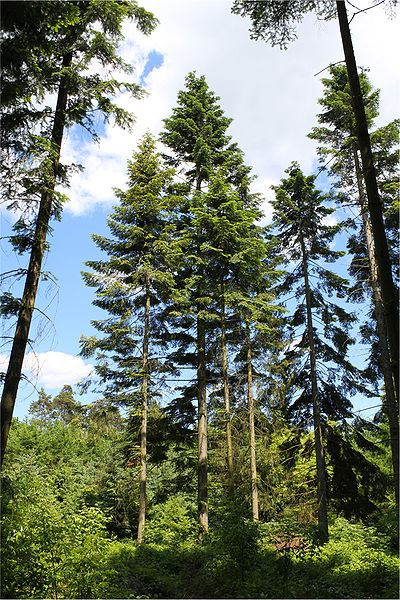|
Abies grandis (grand fir, giant fir, lowland white fir, great silver fir, western white fir, Vancouver fir, or Oregon fir) is a fir native to the Pacific Northwest and Northern California of North America, occurring at altitudes of sea level to 1,700 metres (5,600 ft). It is a major constituent of the Grand Fir/Douglas Fir Ecoregion of the Cascade Range.
The tree typically grows to 40–70 m (130–230 ft) in height, and may be the tallest Abies species in the world. There are two varieties, the taller coast grand fir, found west of the Cascade Mountains, and the shorter interior grand fir, found east of the Cascades. It was first described in 1831 by David Douglas.[2]
It is closely related to white fir. The bark was historically believed to have medicinal properties, and it is popular in the United States as a Christmas tree. Its lumber is a softwood, and it is harvested as a hem fir. It is used in paper-making, as well as construction for framing and flooring, where it is desired for its resistance to splitting and splintering.
Description

|
Abies grandis is a large evergreen conifer growing to 40–70 metres (130–230 feet) tall, exceptionally 100 m (330 ft), with a trunk diameter of up to 2 m (6 ft 7 in). The dead tree tops sometimes fork into new growth. The bark is 5 centimetres (2 inches) thick, reddish to gray (but purple within), furrowed, and divided into slender plates. The leaves are needle-like, flattened, 3–6 cm (1+1⁄8–2+3⁄8 in) long and 2 millimetres (3⁄32 in) wide by 0.5 mm thick, glossy dark green above, with two green-white bands of stomata below, and slightly notched at the tip. The leaf arrangement is spiral on the shoot, but with each leaf variably twisted at the base s they all lie in two more-or-less flat ranks on either side of the shoot. On the lower leaf surface, two green-white bands of stomata are prominent. The base of each leaf is twisted a variable amount so that the leaves are nearly coplanar. |

|
The green-to-reddish cones are 6–12 cm (2+1⁄4–4+3⁄4 in) long and 3.5–4.5 cm (1+1⁄2–1+3⁄4 in) broad, with about 100–150 scales; the scale bracts are short, and hidden in the closed cone. The winged seeds are released when the cones disintegrate at maturity about 6 months after pollination. |
|

|


